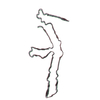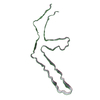+ Open data
Open data
- Basic information
Basic information
| Entry | Database: PDB / ID: 9gg6 | |||||||||||||||||||||
|---|---|---|---|---|---|---|---|---|---|---|---|---|---|---|---|---|---|---|---|---|---|---|
| Title | P301T type II tau filaments from human brain | |||||||||||||||||||||
 Components Components | Isoform Tau-F of Microtubule-associated protein tau | |||||||||||||||||||||
 Keywords Keywords | PROTEIN FIBRIL / P301T tau / Frontotemporal dementia and parkinsonism linked to chromosome 17 / Electron cryo-microscopy | |||||||||||||||||||||
| Function / homology |  Function and homology information Function and homology informationplus-end-directed organelle transport along microtubule / histone-dependent DNA binding / negative regulation of establishment of protein localization to mitochondrion / neurofibrillary tangle / microtubule lateral binding / axonal transport / tubulin complex / positive regulation of protein localization to synapse / phosphatidylinositol bisphosphate binding / negative regulation of tubulin deacetylation ...plus-end-directed organelle transport along microtubule / histone-dependent DNA binding / negative regulation of establishment of protein localization to mitochondrion / neurofibrillary tangle / microtubule lateral binding / axonal transport / tubulin complex / positive regulation of protein localization to synapse / phosphatidylinositol bisphosphate binding / negative regulation of tubulin deacetylation / generation of neurons / rRNA metabolic process / axonal transport of mitochondrion / regulation of mitochondrial fission / axon development / regulation of chromosome organization / central nervous system neuron development / intracellular distribution of mitochondria / minor groove of adenine-thymine-rich DNA binding / lipoprotein particle binding / microtubule polymerization / negative regulation of mitochondrial membrane potential / regulation of microtubule polymerization / dynactin binding / apolipoprotein binding / main axon / protein polymerization / glial cell projection / axolemma / negative regulation of mitochondrial fission / Caspase-mediated cleavage of cytoskeletal proteins / regulation of microtubule polymerization or depolymerization / neurofibrillary tangle assembly / positive regulation of axon extension / Activation of AMPK downstream of NMDARs / regulation of cellular response to heat / synapse assembly / positive regulation of superoxide anion generation / supramolecular fiber organization / regulation of long-term synaptic depression / positive regulation of protein localization / cellular response to brain-derived neurotrophic factor stimulus / regulation of calcium-mediated signaling / cytoplasmic microtubule organization / positive regulation of microtubule polymerization / somatodendritic compartment / axon cytoplasm / astrocyte activation / stress granule assembly / phosphatidylinositol binding / nuclear periphery / regulation of microtubule cytoskeleton organization / protein phosphatase 2A binding / cellular response to reactive oxygen species / Hsp90 protein binding / microglial cell activation / synapse organization / PKR-mediated signaling / cellular response to nerve growth factor stimulus / protein homooligomerization / regulation of synaptic plasticity / SH3 domain binding / response to lead ion / microtubule cytoskeleton organization / memory / cytoplasmic ribonucleoprotein granule / neuron projection development / cell-cell signaling / single-stranded DNA binding / protein-folding chaperone binding / actin binding / cellular response to heat / growth cone / microtubule cytoskeleton / cell body / double-stranded DNA binding / protein-macromolecule adaptor activity / microtubule binding / dendritic spine / sequence-specific DNA binding / amyloid fibril formation / microtubule / learning or memory / neuron projection / regulation of autophagy / membrane raft / axon / negative regulation of gene expression / neuronal cell body / dendrite / DNA damage response / protein kinase binding / enzyme binding / mitochondrion / DNA binding / RNA binding / extracellular region / identical protein binding / nucleus / plasma membrane Similarity search - Function | |||||||||||||||||||||
| Biological species |  Homo sapiens (human) Homo sapiens (human) | |||||||||||||||||||||
| Method | ELECTRON MICROSCOPY / helical reconstruction / cryo EM / Resolution: 3.36 Å | |||||||||||||||||||||
 Authors Authors | Schweighauser, M. / Shi, Y. / Murzin, A.G. / Garringer, H.J. / Vidal, R. / Murrell, J.R. / Erro, M.E. / Seelaar, H. / Ferrer, I. / van Swieten, J.C. ...Schweighauser, M. / Shi, Y. / Murzin, A.G. / Garringer, H.J. / Vidal, R. / Murrell, J.R. / Erro, M.E. / Seelaar, H. / Ferrer, I. / van Swieten, J.C. / Ghetti, B. / Scheres, S.H.W. / Goedert, M. | |||||||||||||||||||||
| Funding support |  United Kingdom, United Kingdom,  China, China,  United States, 6items United States, 6items
| |||||||||||||||||||||
 Citation Citation |  Journal: bioRxiv / Year: 2024 Journal: bioRxiv / Year: 2024Title: Novel tau filament folds in individuals with mutations P301L and P301T. Authors: Manuel Schweighauser / Yang Shi / Alexey G Murzin / Holly J Garringer / Ruben Vidal / Jill R Murrell / M Elena Erro / Harro Seelaar / Isidro Ferrer / John C van Swieten / Bernardino Ghetti / ...Authors: Manuel Schweighauser / Yang Shi / Alexey G Murzin / Holly J Garringer / Ruben Vidal / Jill R Murrell / M Elena Erro / Harro Seelaar / Isidro Ferrer / John C van Swieten / Bernardino Ghetti / Sjors H W Scheres / Michel Goedert /      Abstract: Mutations in , the microtubule-associated protein tau gene, give rise to cases of frontotemporal dementia and parkinsonism linked to chromosome 17 (FTDP-17) with abundant filamentous tau inclusions ...Mutations in , the microtubule-associated protein tau gene, give rise to cases of frontotemporal dementia and parkinsonism linked to chromosome 17 (FTDP-17) with abundant filamentous tau inclusions in brain cells. Individuals with pathological variants exhibit behavioural changes, cognitive impairment and signs of parkinsonism. Missense mutations of residue P301, which are the most common mutations associated with FTDP-17, give rise to the assembly of mutant four-repeat tau into filamentous inclusions, in the absence of extracellular deposits. Here we report the cryo-EM structures of tau filaments from five individuals belonging to three unrelated families with mutation P301L and from one individual belonging to a family with mutation P301T. A novel three-lobed tau fold resembling the two-layered tau fold of Pick's disease was present in all cases with the P301L tau mutation. Two different tau folds were found in the case with mutation P301T, the less abundant of which was a variant of the three-lobed fold. The major P301T tau fold was V-shaped, with partial similarity to the four-layered tau folds of corticobasal degeneration and argyrophilic grain disease. These findings suggest that FTDP-17 with mutations in P301 should be considered distinct inherited tauopathies and that model systems with these mutations should be used with caution in the study of sporadic tauopathies. | |||||||||||||||||||||
| History |
|
- Structure visualization
Structure visualization
| Structure viewer | Molecule:  Molmil Molmil Jmol/JSmol Jmol/JSmol |
|---|
- Downloads & links
Downloads & links
- Download
Download
| PDBx/mmCIF format |  9gg6.cif.gz 9gg6.cif.gz | 60.2 KB | Display |  PDBx/mmCIF format PDBx/mmCIF format |
|---|---|---|---|---|
| PDB format |  pdb9gg6.ent.gz pdb9gg6.ent.gz | 45.4 KB | Display |  PDB format PDB format |
| PDBx/mmJSON format |  9gg6.json.gz 9gg6.json.gz | Tree view |  PDBx/mmJSON format PDBx/mmJSON format | |
| Others |  Other downloads Other downloads |
-Validation report
| Summary document |  9gg6_validation.pdf.gz 9gg6_validation.pdf.gz | 1.4 MB | Display |  wwPDB validaton report wwPDB validaton report |
|---|---|---|---|---|
| Full document |  9gg6_full_validation.pdf.gz 9gg6_full_validation.pdf.gz | 1.4 MB | Display | |
| Data in XML |  9gg6_validation.xml.gz 9gg6_validation.xml.gz | 29.6 KB | Display | |
| Data in CIF |  9gg6_validation.cif.gz 9gg6_validation.cif.gz | 40.7 KB | Display | |
| Arichive directory |  https://data.pdbj.org/pub/pdb/validation_reports/gg/9gg6 https://data.pdbj.org/pub/pdb/validation_reports/gg/9gg6 ftp://data.pdbj.org/pub/pdb/validation_reports/gg/9gg6 ftp://data.pdbj.org/pub/pdb/validation_reports/gg/9gg6 | HTTPS FTP |
-Related structure data
| Related structure data |  51325MC  9gg0C  9gg1C M: map data used to model this data C: citing same article ( |
|---|---|
| Similar structure data | Similarity search - Function & homology  F&H Search F&H Search |
- Links
Links
- Assembly
Assembly
| Deposited unit | 
|
|---|---|
| 1 |
|
- Components
Components
| #1: Protein | Mass: 10206.698 Da / Num. of mol.: 3 / Source method: isolated from a natural source / Source: (natural)  Homo sapiens (human) / Organ: Brain / Tissue: Frontal Cortex / References: UniProt: P10636 Homo sapiens (human) / Organ: Brain / Tissue: Frontal Cortex / References: UniProt: P10636 |
|---|
-Experimental details
-Experiment
| Experiment | Method: ELECTRON MICROSCOPY |
|---|---|
| EM experiment | Aggregation state: FILAMENT / 3D reconstruction method: helical reconstruction |
- Sample preparation
Sample preparation
| Component | Name: P301T Type II Tau Protein Filament / Type: TISSUE / Details: P301T tau filaments extracted from human brain. / Entity ID: all / Source: NATURAL |
|---|---|
| Source (natural) | Organism:  Homo sapiens (human) / Organ: Brain / Tissue: Frontal Cortex Homo sapiens (human) / Organ: Brain / Tissue: Frontal Cortex |
| Buffer solution | pH: 7.4 |
| Specimen | Embedding applied: NO / Shadowing applied: NO / Staining applied: NO / Vitrification applied: YES |
| Specimen support | Grid material: GOLD / Grid mesh size: 300 divisions/in. / Grid type: Quantifoil R1.2/1.3 |
| Vitrification | Cryogen name: ETHANE / Humidity: 100 % / Chamber temperature: 277 K |
- Electron microscopy imaging
Electron microscopy imaging
| Experimental equipment |  Model: Titan Krios / Image courtesy: FEI Company |
|---|---|
| Microscopy | Model: FEI TITAN KRIOS |
| Electron gun | Electron source:  FIELD EMISSION GUN / Accelerating voltage: 300 kV / Illumination mode: FLOOD BEAM FIELD EMISSION GUN / Accelerating voltage: 300 kV / Illumination mode: FLOOD BEAM |
| Electron lens | Mode: BRIGHT FIELD / Nominal defocus max: 2600 nm / Nominal defocus min: 1000 nm |
| Image recording | Electron dose: 42 e/Å2 / Film or detector model: FEI FALCON IV (4k x 4k) |
- Processing
Processing
| EM software |
| ||||||||||||||||||||
|---|---|---|---|---|---|---|---|---|---|---|---|---|---|---|---|---|---|---|---|---|---|
| CTF correction | Type: PHASE FLIPPING AND AMPLITUDE CORRECTION | ||||||||||||||||||||
| Helical symmerty | Angular rotation/subunit: -0.77 ° / Axial rise/subunit: 4.79 Å / Axial symmetry: C1 | ||||||||||||||||||||
| 3D reconstruction | Resolution: 3.36 Å / Resolution method: FSC 0.143 CUT-OFF / Num. of particles: 3795 / Symmetry type: HELICAL | ||||||||||||||||||||
| Atomic model building | Protocol: AB INITIO MODEL |
 Movie
Movie Controller
Controller





 PDBj
PDBj




